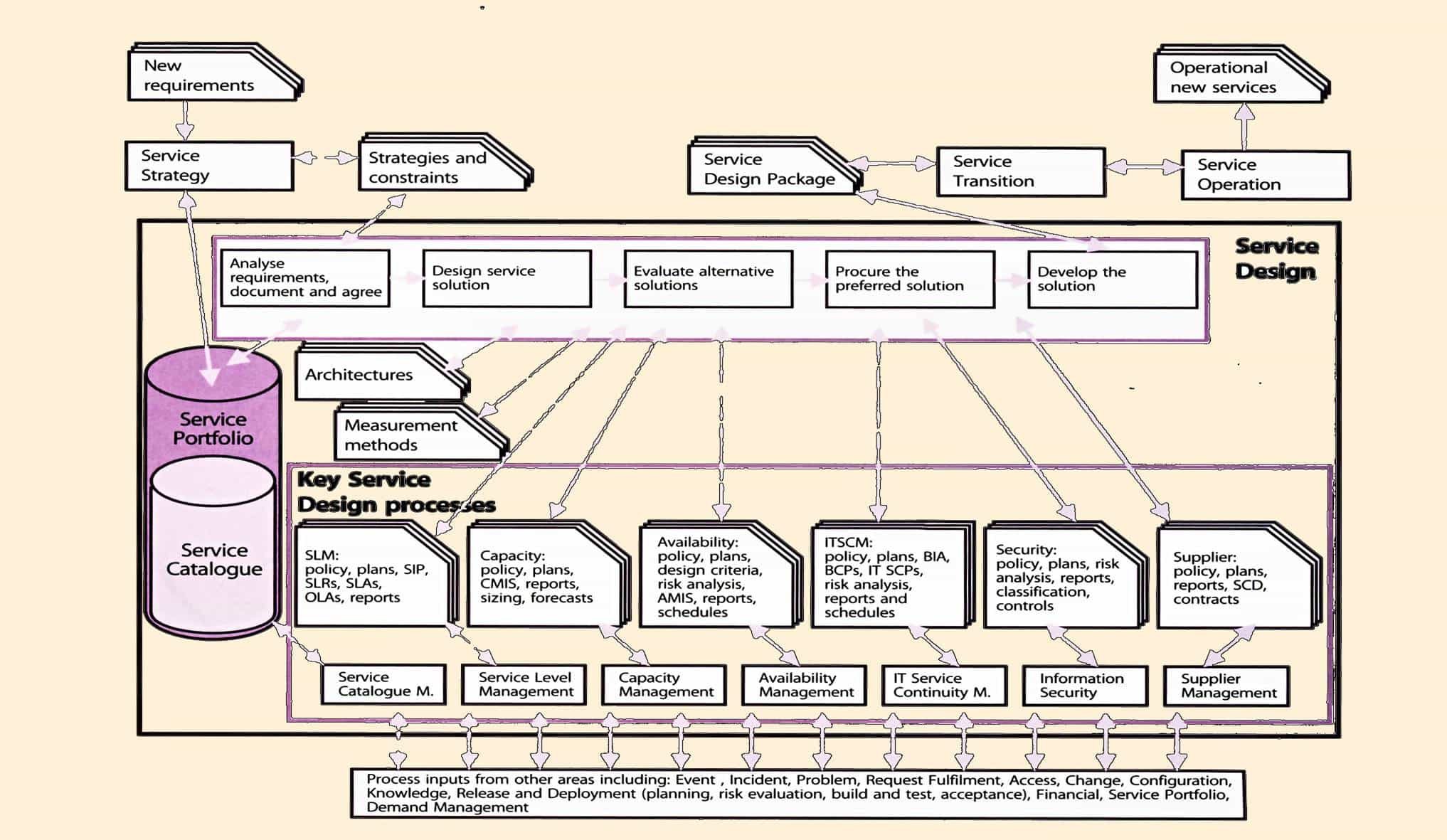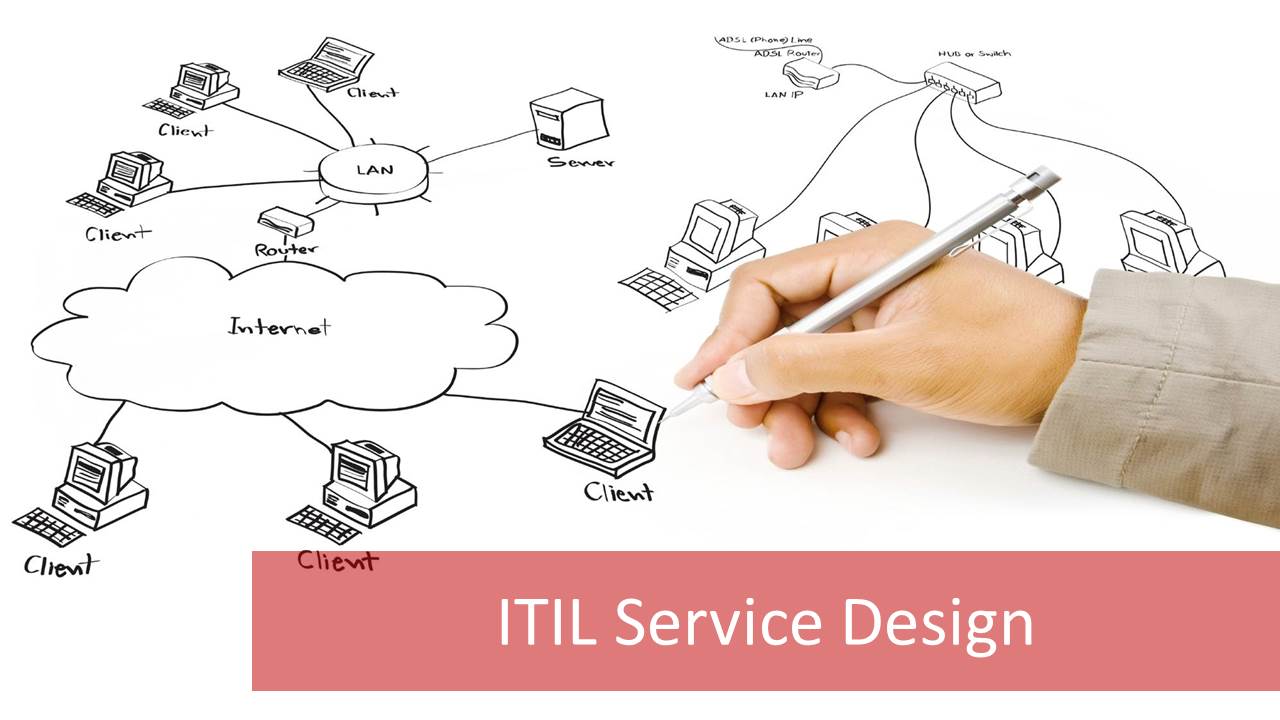Service design is the second stage of the ITIL Lifecycle and ensures the design of new services or the redesign of existing services to meet the strategies generated during the Service Strategy phase. Based on the developed strategies during the first stage of the ITIL Service Lifecycle, new services or changes to existing services are design in this second phase of the ITIL service lifecycle: Service Design. Any good ITIL foundation training course would explain in detail how the ITIL service lifecycle works.
This figure shows the interaction of ITIL Service Design with the other stages of the ITIL lifecycle for services and also what happens in the Service Design stage. New business strategic objectives and requirements come from the service strategy phase of the ITIL service lifecycle. These requirements are evaluated with the existing services considering the service portfolio and catalog in Service Design phase. Requirements coming from the business objectives and strategy are analyzed and arranged first. Then, service solutions are designed. Alternative solutions to meet the business requirements coming from the service strategy phase are evaluated. Based on the analysis and scoring the possible alternatives, the optimum solution for the requirement is drawn up. And in the last step, the solution is developed. IT service managers with ITIL certification online will easily be able to apply Service Design processes.

Service Design Processes
When following these steps in Service Design stage, ITIL processes of the Service Design help to produce the outputs. Service Design processes are:
- Service Catalog Management
- Service Level Management
- Capacity Management
- Availability Management
- IT Service Continuity Management
- Information Security Management
- Supplier Management
Service Design Process: Service Catalog Management
A service catalog is an information management system. Service catalog management as a Service Design process has four goals:
- Producing and maintaining a service catalog for the organization
- Getting and maintaining accurate information on all operational services
- Getting and maintaining accurate information on all services awaiting deployment
There are several processes that need to be followed in service catalog management. It comes down to managing the information in the service catalog and ensuring that the information in the catalog stays current. Finally, the services manager responsible for managing the service catalog must ensure that the catalog contains details regarding the details, status, interface and dependencies of each and every service.
Service Design Process: Service Level Management
This Service Design process ensures that the agreed level of all IT services is provided. During this process, the service levels are defined, documented, agreed upon, monitored, measured, reported and reviewed. The IT services manager must ensure that specific and measurable targets are developed for all IT services. These metrics are monitored and pro-active measures are taken to improve the level of services and increase customer satisfaction.

During service level management, the alignment between the IT service provider and the business is developed. Service managers manage the expectations and perceptions of the business, customers, and users. They have to negotiate and arrange current and future requirements of service level and agreements as well as manage operational level agreements.
Service Design Process: Capacity Management
The objectives of capacity management within the framework of Service Design involves producing and maintaining an appropriate and up-to-date Capacity Plan. The service manager responsible for capacity management will provide advice and guidance on all capacity and performance related issues. Capacity management ensures that service performance achievements meet or exceed the targets. It also involves assisting with the diagnosis and resolution of performance and capacity related incidents and problems. In addition, it is the process that assesses the impact of all changes on the Capacity Plan and the performance and capacity of all services.
Service Design Process: Availability Management
Availability management as a Service Design process comes down to ensuring that the level of service availability meets or exceeds the current and the future agreed upon needs of the business in a cost efficient way for all delivered services. There are a few important aspects that need to be taken into account during availability management
- Reliability: The measuring of how long a service, component or configuration item can perform its agreed function without interruption.
- Maintainability: The measuring of how quickly and effectively a service, component or configuration item can be restored to normal working after a failure.
- Serviceability: The ability of a third-party supplier to meet the terms of their contract availability, reliability and/or maintainability.

Service Design Process: IT Service Continuity Management
The goals of IT service continuity management as a Service Design process is to support the overall business continuity management plans by ensuring that the required IT technical service facilities can be resumed within the required business timescales. The objectives of IT service continuity management are to maintain a set of IT service continuity and IT recovery plans. During this process, regular business impact analysis must be performed. IT service managers must give advice and guidance on all continuity and recovery related issues. They must also assess the impact of all changes on the IT service continuity plans and IT recovery plans.
Service Design Process: Information Security Management
This Service Design process is the management of service activities within the corporate governance framework. It provides the strategic direction for security activities and ensures that data security objectives are achieved. Information security management ensures that information on security risks are appropriately managed. It also ensures that confidentiality, integrity, availability and authenticity are upheld.
Service Design Process: Supplier management
In the Service Design process, effective management of suppliers and their services enables the delivery of excellent quality IT services. It also assures that a return on investment is obtained either through added value or revenue to the business. Business needs are aligned with the contracts that will be signed with the supplier with supporting targets agreed upon. The business will manage the supplier performance according to the performance measures stipulated in their contracts.
Service Design is an important step in the ITIL Service Lifecycle which bridges the ITIL Service Strategy and the ITIL Service Transition stages in this lifecycle. Following the proper procedures during this stage will ensure the design of effective and efficient IT services that brings value to the customer and the business.
Review by: Lauren Peterson


12 thoughts on “Get the Scoop on ITIL Service Design”
Comments are closed.